Blog posts tagged with 'embroidery'
Remember those delicate fragile family heirloom Christmas ornaments that you were never allowed to touch as a kid? Now you can get that same shiny look with your embroidery machine and a small bit of Mylar. And they can't shatter on the floor!

Introducing "All That Glitters" for the Designer in You!
All That Glitters Mylar Christmas Designs was thoughtfully designed for the creative embroiderer. It includes 11 round ornaments and 9 "add-on" embellishments plus a bonus ornament. These embroideries are designed for maximum flexibility! You can stitch them with or without Mylar.

You can stitch them as standard applique with or without the background fill. You can stitch them as direct embroidery or free-standing applique. You can combine the add-ons to the Mylar filled versions or the plain applique. You can even mix in other designs from your stash to extend the designs even further. The following sample uses one of the included monogram fonts with Essentials combined with a bow add-on and the center feature ornament.

To make them fast and easy, they have few color changes and low stitch counts. Also, since all but one ornament use the same applique shape, you can easily mix and match fabrics. If you have a digital cutter, you can really go to town and still whip up a batch before Christmas! In addition to the designs, the collection includes applique templates for hand or machine cutting. All the round bulbs use the same shape so cutting enmass is simple. There is also the circular pattern for the center feature and the shape for the "mint" shape, which is somewhat of an extra with this collection.

Sometimes it's the simpler designs that offer the most creativity and flexibility!
Designing with the Center Feature Ornament
The center feature design offers quite a bit of possibilities. I've fussy cut a piece of fabric from my stash as an insert. You could also you a photo printed fabric insert or a pretty holiday colored fabric with a monogram or short word.

With a little more work, you can drop out the Mylar fill and replace it with a standard applique fabric. Then with your lettering software, arc some text into the area. How about a fabric print of your child's school picture with the year underneath for the grandparents?

If you're observant, you'll notice that this design was digitized in StitchArtist. I had hoped to release these as BX design library but that part of the program is not functioning yet so I'm just releasing the standard stitch file formats I usually support. The highlighted object in the Objects panel on the upper right is the Mylar fill section. Just delete it if you don't want it for your edited version.
Maximum Flexibility Designs!
These designs have been programmed with multiple color stops to make customizing easy. For example the light fills intended to stitch over Mylar can easily be deleted in software or skipped at the machine. Likewise, the second color on the ornament cap—which I've run in the same color as the rest of the cap—is only necessary if you want to do free-standing applique. Otherwise you can skip or delete it. I've included multiple Mylar fills so you can select one you like. Here's one that doesn't have any Mylar under it so you can see the stitches:

Appliques & Extra Colors
If you've never sew machine embroidered applique, there can be up to 3 color stops in the design for each applique. First is the position stitch, which is most often a run that outlines where the applique goes. Second is the tack down stitch. In my designs, I most often use a zigzag here because it catches the fabric better and is less likely to push a little pleat into the fabric. Finally the cover stitching—usually a satin—runs. When you look at your actually stitch file, these all need to be separate colors if they run consecutively, otherwise your machine won't stop. Therefore you need to refer to the color sequence list. I do understand there are people who think this might be too difficult—skipping colors or using software—so I have included a plain applique ornament. I promise you though, simple modifications like this really are simple once you try it!

Add-On Embellishments
The add-ons can be combined with any of the Mylar fills or the plain applique. You can combine them either at your machine or in software. While all the designs and individual add-ons will fit a 4x4 hoop, if you add a bow to the top of an ornament, you'll likely need a larger hoop or you can rehoop or use a multi-position hoop. (Instructions not included for that!)

Of course, the add-ons can work stand alone and feel free to sort through your stash for other suitable designs you can combine. The basic round ornament and the Mylar fills are perfect for that!
Advanced Customizing
I've done all my designs on the first few ornaments on top of the curved fill variation. Depending on the color of thread and Mylar you use, the various background fills may be more or less prominent. If you decide you like the swirly design on Swirls 2 and the meandering fill on Mylar Fill 6, it's not terribly difficult to isolate and copy the color block for the swirls and paste it into the right place on the other design. For the designs on the first few ornaments that are more "finished" it was important that the designs be a little more integrated than just dropping in an add-on at the end of the design. But that doesn't mean it's major surgery to extract them and use them on one of the other ornaments.
Customize with Color
These designs can be stitched with any colors you like. In fact, when I started stitching them, I chose entirely different colors from what I picked when digitizing. On Swirls 2 I used a light blue Mylar and stitched over it with white to soften it a bit. I was going for a wintry, cold look here. The white softened the blue color even more and the stitches breaking up the Mylar gave it almost a crystalline appearance.

How to Embroider with Mylar
Mylar works best when stitched under a light fill. The lighter the fill, the more the Mylar can sparkle through. All the sparkle in the designs you see here comes form the Mylar. Of course you could add even more with metallic thread. For these designs I've created curved and motif fills use Embrilliance StitchArtist. I have two YouTube videos on how to create the curved fill and the stitch carving you see on the caps of the ornaments. If you have StitchArtist Level 3 you can duplicate these techniques.
Mylar is available in colors from Nancy's Notions. I sprung for the mega pack because I couldn't decide which colors to order. According to the description, this product is machine washable but I haven't actually tried that.
Another alternative to Mylar that I've used for years and years is party balloons. I think these fill densities might be a little too open for the printed side of the balloon but the inside is silver and looks just like those old family heirloom ornaments. Below you can see some early samples, one that was modified and two that didn't make the cut for various reasons. These are stitched on the "wrong" side of the happy face balloon shown following. Ask for damaged balloons at the party store and you can often get them for free!


hese designs are set up as standard appliques. Sew the first color to get the placement line.

Then lightly mist the back of a 4x4" square of Mylar with TESA (I use KK2000) and smooth it over the stitching line.

Sew the design up through the background fill then stop the machine and carefully tear off the Mylar. If you tear toward the stitching line you'll get a nice clean finish.

Don't forget the middle!

Then complete the rest of the stitching. This design has a second applique for the center. Place the precut fabric and then stop the machine after the zigzag tack down (if it doesn't stop automatically) to inspect your work. The zigzag should just cover the edge of the fabric and there shouldn't be any excess extending out beyond the edge.

I usually precut all my appliques before placing them in the hoop. However, Mylar is a bit tricky to work with and since it is so easy to tear off after stitching it in place, I just use the "blob method" of applique in this case.
Stitching with Fabric?
If you're doing actual applique with fabric, then use the pattern pieces to precut your fabrics. You can either cut by hand or by machine as long as it's accurate. I also like to use a fusible web on the back of my fabrics for a smooth, long lasting great appearance. Instead of placing the Mylar, position your pre-cut applique exactly within the sewn lines. The next color will zigzag tack it in place. If any fabric is extending beyond the zigzag you either incorrectly cut or placed your fabric and you'll likely have fabric extending beyond your applique. Carefully try to trim off any excess without cutting any stitches or disturbing your fabric tension in the hoop.
What's Included with the Collection
All That Glitters Mylar Christmas Designs includes 21 designs in all the supported formats usually found in my shop. The collection also includes color sequences, templates, and instructions for standard applique and a reprint of this blog post as a PDF for off-line reference.

The designs are also available individually. Please note that instructions are not included on individual designs. I'll be posting videos on how to use these designs on YouTube so go there and subscribe and you'll get an email notification of when they're available.

- 2 projects for 100x100mm sewing fields
- 3 projects for 130x180mm sewing fields
- 1 project for 200 x 300mm sewing fields
Two of these are the zipped pencil case designed for stitching with woven fabric. The 4 other projects are intended for vinyl, cork, leather, or felt.
This PDF covers the pencil cases. Both cases are constructed exactly the same. The only difference is the size.
The vinyl projects are covered separately.
Skill Level
What You’ll Need
- Suitable fabrics, pre-washed and pressed. I used quilt-weight cottons. (Tip: If fabrics are especially soft, starching can reduce distortion when stitching if you aren’t applying interfacing.)
- Rotary cutter, quilting ruler and mat
- Stabilizer: I used Sulky Soft ‘n Sheer.
- Batting: I used Warm and Natural
- Fusible interfacing: I used Pellon ShirTailor
- Steam-a-Seam 2 for appliqué
- Steam-a-Seam 2: 1/4’ wide hem tape
- Wonder Tape
- Polyester or nylon zipper, at least 2” longer than the width of your bag, color of your choice
- Scissors used:
- For trimming batting
- Thread snips
- Heavy scissors for final trim
- Optional bag hardware of your choice
- Suitable embroidery threads
- Tape (Scotch invisible, painter’s tape, or similar
Getting Started
You’ll need to do some prep work before starting the embroidery:
- Cut, press, and prepare all your fabrics
- Make any loops you might be adding
- Prepare the back pocket
Fabric Requirements
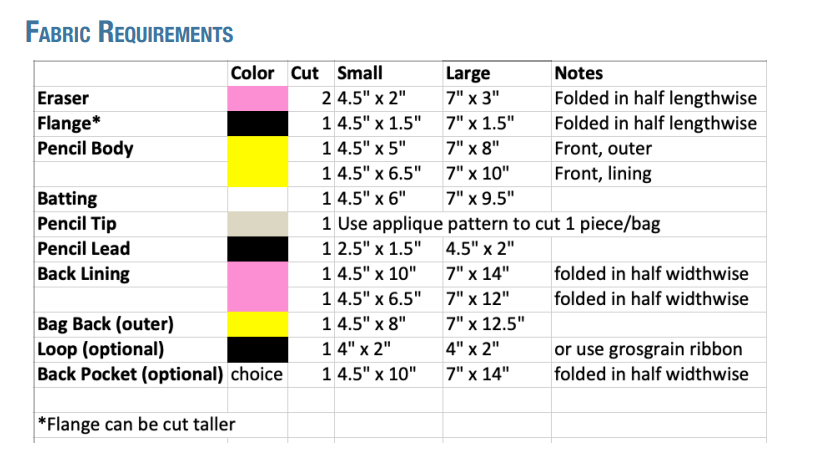
Prepare All the Fabrics
- These bags, especially the smaller one, require only small bits of fabric. Raid your scrap bin!
- Medium weight cottons or cotton/poly blends work best.
- Cut fabrics on grain, paying attention to any directional prints. A rotary cutter, ruler, and mat are easiest.
- Press all fabrics smooth (I prewash everything).
- Starching or interfacing your fabrics can make them easier to keep flat in the hoop. Interfacing all pieces can make your bag harder to turn. Starch smaller pieces. For the small version, I only interfaced the bag back piece.
- Fusible interfacing can be applied to selected pieces for a more professional finish. For the large bag, I interfaced the front eraser piece, the front lining, the back panel, and the pocket.
- I used Warm and Natural batting on the lower front panel only. I interfaced the top front piece and the back panel. If you aren’t including batting in your version, I suggest you also interface the lower front outer piece.
- Note for Small Version: To minimize bulk on the smaller one, consider skipping some of the interfacing, not fully lining the pocket (or skipping the pocket addition altogether), and not using doubled fabrics for the back lining. See the video for tips.
Make Loops
Loops are totally optional. You can make them any length and place them on the side or the top in the eraser area (from just below the zipper on either side). This is where a reinforcing stitch is included. Loops can be placed elsewhere but they will only be stitched down by the final seam line. You may wish to add some stay stitching at the sewing machine before turning right side out.- TIP 1: If you add the flange, make sure the loop does not overlap it to avoid too much bulk in one area.
- TIP 2: You can reduce bulk by not stacking the ends of your loop together and instead place them side-by-side. (See following images…)
- TIP 3: If you are making a loop long enough to use as a handle, consider adding interfacing to the inside of the loop to make it more durable.


Prepare Optional Back Pocket
The back pocket is totally optional and is another way you can customize this project.Embroidering the Bag
This project has a lot of steps that must be done in the right order for a successful result. Pay attention to when and where pieces are placed and whether they go face down or face up and on which side of the hoop.- Note: The color sequence list includes many colors. This is to get the machine to stop. You can use whatever colors work best with your project. On the purple pencil I made in the video, I used only one color of purple. In the steps below, I included the color I used for the yellow pencil bags.
- TIP: Lining pieces are placed on the BACK/BOTTOM of the hoop; outer pieces are placed on the FRONT/TOP of the hoop.
1. Setup:
- Hoop the stabilizer and stitch color 1 for a placement guide.

- The final stitching line will be 1mm within this line. [PINK]
2. Zipper:
- Apply Wonder Tape to stabilizer next to the zipper placement guides and position zipper
- Make sure the metal ends are outside of the stitching lining. Zipper can open from either side you choose and must be place right side up.

- Stitch color 2 to attach zipper to the stabilizer. [PINK]
3. Eraser:
- Apply pieces, face down, matching raw edges to edge to zipper tape on both the front and back. Hold in place with a few pieces of tape.

Sew color 3. [PINK]
- Fold pieces both pieces back, finger press, tape to secure, and sew color 4 to topstitch and baste to the stabilizer. [PINK]

- 4. Pencil Body:
- Apply lining piece, face down, matching raw edges to edge to bottom edge zipper tape on both the back. Hold in place with a few pieces of tape. Sew color 5. [YELLOW]

- Optional: Place flange matching the raw edges to the placement guide (bottom edge of zipper). Secure with tape. I used Wonder Tape to make sure it stayed straight.


- Apply front piece, face down, matching raw edges to edge to bottom edge zipper tape on the front. Hold in place with a few pieces of tape.

- Sew color 5. [YELLOW]
- Position batting so that the top edge abuts the seam edge, not the seam line

- Sew color 6 [YELLOW] to secure batting. Remove the hoop and trim the batting next to the stitching line to minimize bulk in the seams later on.

- Fold the front bag body piece down while keeping flange and lining still up out of the way.
- Sew Color 7 [YELLOW] to attach front piece to the stabilizer and sew the lines on the pencil body
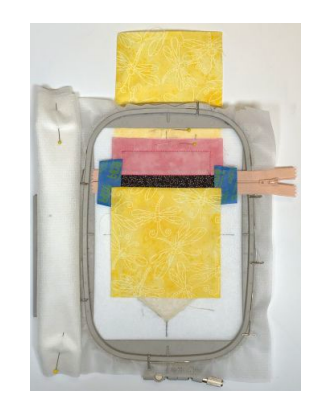
- Trim off excess fabric below zigzag placement line to reduce fabric bulk at the pencil tip.
- TIP: If you want to add in another design, such as a name or monogram, here’s the place to insert it.
- 5. Pencil Tip:
- The “wood” part of the pencil tip is an applique. Position the applique matching the zigzag edge to the placement line and sew color 8 [YELLOW] to tack it down.
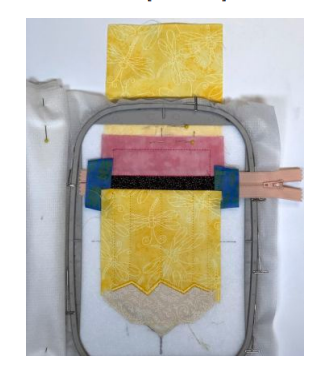
- 6. Pencil Lead:
- Place the small back fabric face down aligning the raw edge just beyond the “wood” applique edge.
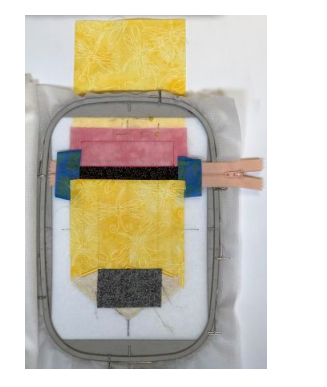
- Sew color 9 [Black] to attach it.
- Fold the fabric down, finger press it and secure it in place. 7. Top Stitch the Flange & Lining:
- Apply Steam-a-Seam tape to the back of the flange near the seam line. Fold it down and press with an applique tacking iron to secure it.
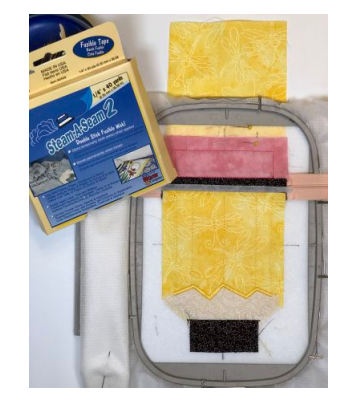
- Fold down the front bag lining on the back of the hoop, finger press, and secure in place.
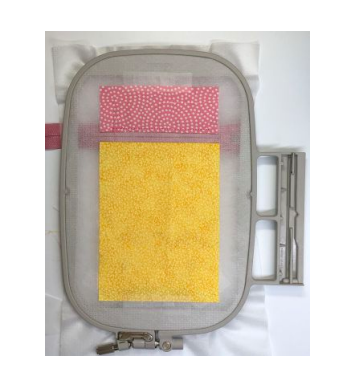
- Sew color 11 [BLACK] to topstitch next to the zipper
- 8. Move the Zipper Tab:
- Open the zipper so that the tab is within the body of the bag and the zipper is about 3/4 open.
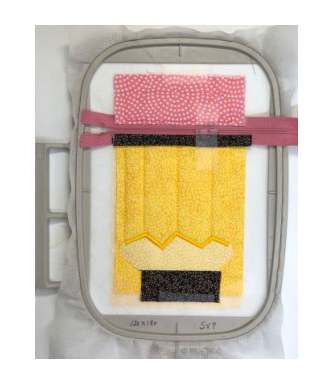
- IMPORTANT: If you skip this step, you won’t be able to turn your bag right side out! 9. Tabs:
- If you have any loops or tabs, you can place them now so that they can be reinforced stitched. Fold the loop in half and place it with the raw edges at least 1/4 beyond the placement line.
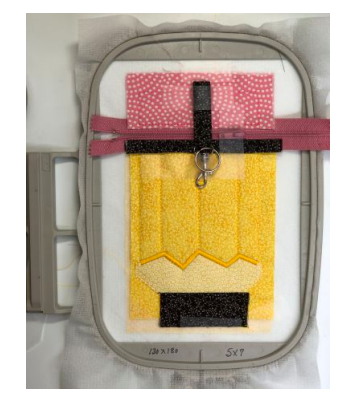
- Be sure to slide on any optional hardware. Make sure any hardware is out of the range of the needle and presser foot!
- Reinforcing stitches run up, across, and down on the upper section only. If you aren’t adding any tabs or loops, you can skip this color change. Sew color 12 in any color.
- TIP 1: If your tab is thick, rather than tack both ends together, place them side by side.
- TIP 2: If you place your tape (cellophane or painter’s), right over the stitching line, you can create a sort of “ramp” that will help your presser foot ride up and over rather than “trip” and catch on a suddenly thicker area.
- TIP 3: Avoid placing tabs over areas that are already thick, such as the flange area.
- TIP 4: The more “stuff” you pile on top of the hoop (loops, hardware, etc.), the bigger your back piece will be relative to the front as it must go over all the extra bulk. While we can compensate for this at the sewing machine by matching the edges of our fabric, that can’t be done in the hoop. You will get extra fabric visible on the back; it’s less prominent on the larger bag.
- 10. Final Assembly:
- On the back of the hoop:
- The back lining is layered on the back. Layer the top piece face down and the bottom piece face down overlapping the finished/folded edges about 1/2”. Tape in place.

- TIP: Apply a strip of Steam-a-Seam tape to the front bottom edge of the top lining piece but do not remove the protective paper until the bag is completely turned. The strip should be ~1” narrower than the width of the bag and be centered.
- On the front of the hoop:
- If you are adding a back pocket, place it face down with the finished edge at the top, keeping it below the zipper and making sure it extends beyond the original placement lines at least 1/4”. Secure with tape.

- Layer the back piece face down and secure with tape
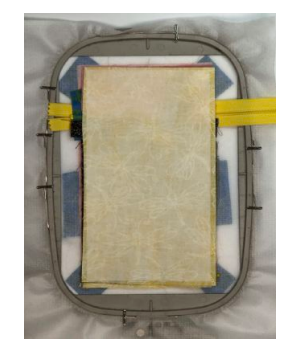
- Sew the last color change. (YELLOW]
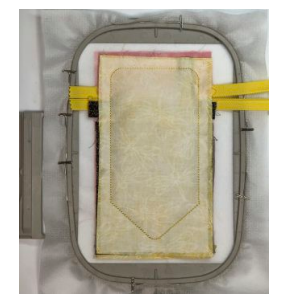
- Remove any tape and pins you may have used
Finishing:
- Remove the project from the hoop. Trim off excess beyond the final seam line leaving about a quarter inch seam allowance. You can clip corners and trim them more closely.
- Turn inside out through the opening in the lining. At this point your project will be inside out. You can seal the opening with a fusible web or hand stitch.
- Trim the stabilizer away from the back of the zipper. This is the only visible stabilizer in the project

- Turn the project one more time through the zipper opening. If the pocket is on the front, just turn it so that it’s on the back.
- Take some time to push out all the corners and the press
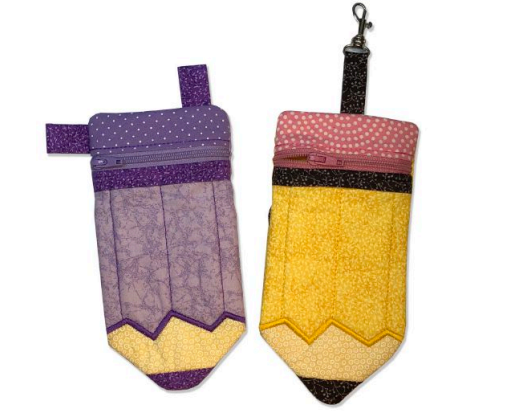
Summary
As you can see by the purple pencil made in the video, you can make your bags in any color combination. Also, if you are experienced with software, you can add a monogram, name, or other embellishment to the front of the bag. Just be sure to stitch it before you bring down the lining piece
- 1
- 2
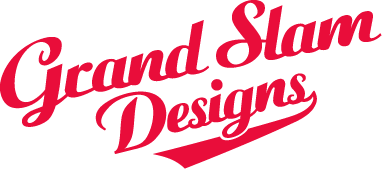












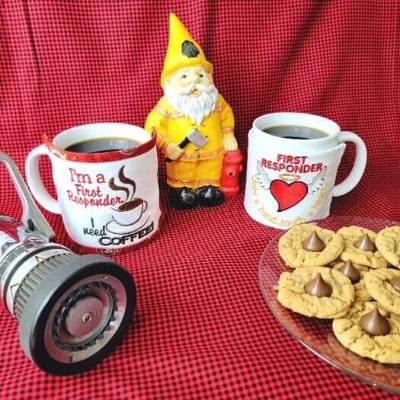
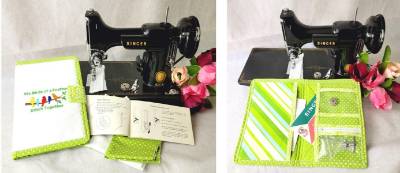
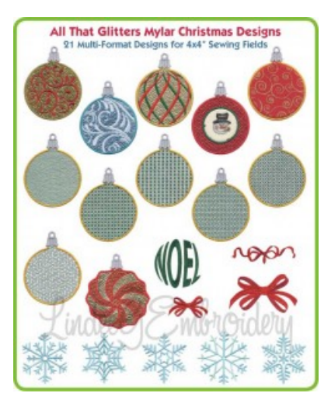
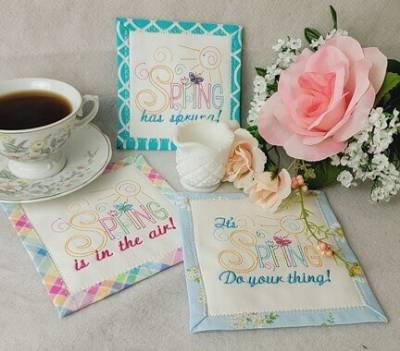
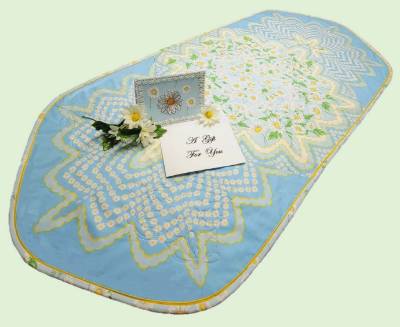

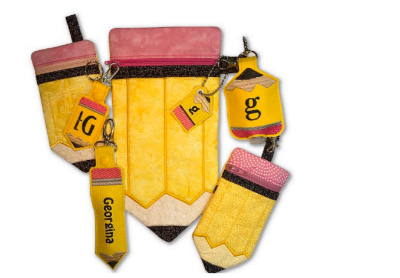
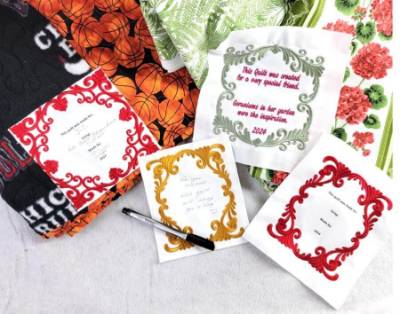
_400.jpeg)
